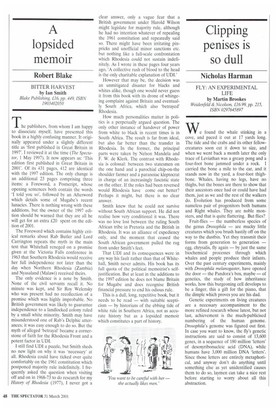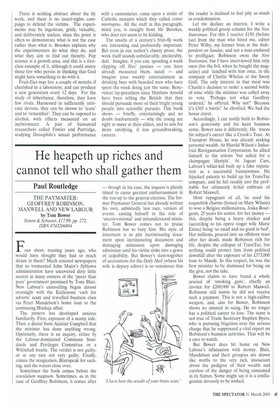Clipping penises is so dull
Nicholas Harman
FLY: AN EXPERIMENTAL LIFE by Martin Brookes Weidenfeld & Nicolson, £16.99, pp. 215, ISBN 0297645897 We found the whale stinking in a cove, and paced it out at 17 yards long. The tide and the crabs and its other fellowcreatures soon cut it down to size, and when we went back a month later the only trace of Leviathan was a greasy pong and a four-foot bone jammed under a rock. I carried the bone a mile to the car, and it stands now in the yard, a four-foot thighbone. Whales, having no legs, have no thighs, but the bones are there to show that their ancestors once had or could have had them, just as we and the rest of the walkers do. Evolution has produced from some nameless pair of progenitors both humans and Right whales. They are noble monsters, and that is quite flattering. But flies?
Fruit-flies — the numberless species of the genus Drosophila — are mucky little creatures which you brush hastily off on the way to the dustbin. Yet they transmit their forms from generation to generation — egg, chrysalis, fly again — by just the same biochemical processes through which whales and people produce their infants. Over the past century experiments, mainly with Drosophila melanogaster, have opened the door — the Pandora's box, maybe — of genetics, the study of how inheritance works, how this burgeoning cell develops to be a finger, this a gift for the piano, that the dimple which proves you are his dad.
Genetic experiments on living creatures are a necessary accompaniment to the more refined research whose latest, but not last, achievement is the much-publicised numbering of the human genome. Drosophila's genome was figured out first. In case you want to know, the fly's genetic instructions are said to consist of 13,600 genes, in a sequence of 180 million 'letters' of desoxyribonucleic acid (DNA), while humans have 3,000 million DNA 'letters'. Since those letters are entirely metaphorical, and anyway don't do anything until something else as yet unidentified causes them to do so, laymen can take a nice rest before starting to worry about all this abstraction.
There is nothing abstract about the fly work, and there is no insect-rights campaign to defend the victims. The experiments may be ingenious, grisly, valuable, and deliberately useless, since the point is often to demonstrate what is not the case rather than what is. Brookes explains why the experimenters do what they do, and what they aim to find out thereby. Pop science is a growth area, and this is a firstclass example of it, although it could annoy those few who persist in thinking that God might have something to do with it.
Fruit-flies may live a couple of months if cherished in a laboratory, and can produce a new generation every 12 days. For the study of inheritance, therefore, they have few rivals. Harnessed in sufficiently intricate devices, they can be shown to 'learn' and to 'remember-. They can be exposed to alcohol, with effects measured on an inebriometer. A pair of humanoid researchers called Fowler and Partridge, studying Drosophila's sexual performance with a castrometer, came upon a strain of Catholic mutants which they called coitus interruptus. All the stuff in this paragraph, mind you, is straight from Mr Brookes, who does not seem to be kidding.
The results of a century's fruit-fly work are interesting and profoundly important. But even in our author's cheery prose, the work itself sounds unbelievably, intolerably, dull. Imagine, if you can, spending a week clipping off flies' penises — you have already measured them, natch — and imagine your weekly entertainment as drinking beer with bearded men who have spent the week doing just the same. Benevolent lay-preachers since Matthew Arnold have been telling the British that they should persuade more of their bright young people into scientific pursuits. This book shows — briefly, entertainingly and no doubt inadvertently — why the young are right to sneer at their elders, and to aim for more satisfying, if less groundbreaking, careers.



























































































 Previous page
Previous page